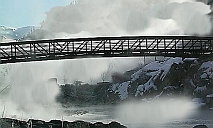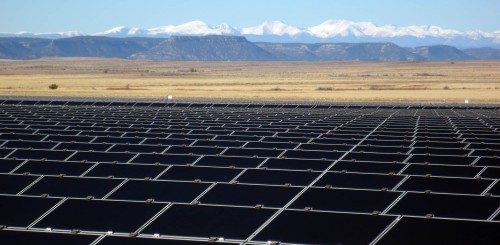|
|
|
RENEWABLE
ENERGY
PROJECTS
Energy
Evaluations and Geothermal Exploration
University of New Mexico |
 TerranearPMC
supported energy exploration
activities to develop geothermal resources at Pagosa Springs in
Colorado. Various techniques were designed and implemented for
subsurface exploration, including mantel, magmatic and radiogenic gas
and water sampling, geo-thermometer calculation fracture, trace
analysis, onsite geologic surveys, and geothermal feature
identification. TerranearPMC authored the Geothermal Play report and
the Geothermal Resource Evaluation report. TerranearPMC
supported energy exploration
activities to develop geothermal resources at Pagosa Springs in
Colorado. Various techniques were designed and implemented for
subsurface exploration, including mantel, magmatic and radiogenic gas
and water sampling, geo-thermometer calculation fracture, trace
analysis, onsite geologic surveys, and geothermal feature
identification. TerranearPMC authored the Geothermal Play report and
the Geothermal Resource Evaluation report. |
Renewable
Energy Option Evaluations and Conceptual Designs
St. Croix
Air National Guard Station |
 TerranearPMC
evaluated renewable energy alternatives and prepared conceptual designs
that incorporated identification of regulations, permits and approvals
as well as development of conceptual build schedules and maintenance
requirements. A detailed analysis of historic electric usage and a
financial analysis was performed, including a 20 year assessment of
revenues from the carbon-neutral generation of electricity based on the
local electric tariff and the expected annual maintenance costs, for: TerranearPMC
evaluated renewable energy alternatives and prepared conceptual designs
that incorporated identification of regulations, permits and approvals
as well as development of conceptual build schedules and maintenance
requirements. A detailed analysis of historic electric usage and a
financial analysis was performed, including a 20 year assessment of
revenues from the carbon-neutral generation of electricity based on the
local electric tariff and the expected annual maintenance costs, for:
|
 |
Solar resources using the National
Solar Radiation Database and Meteonorm |
 |
Four solar PV designs for roof and
ground, using crystalline and amorphous modules |
 |
Wind resources using data from St.
Croix Airport and the National Renewable Energy Laboratory |
 |
Six wind turbine systems including
pole, roof and ground mounted, vertical and horizontal options |
 |
Two integrated solar photovoltaic and
wind turbine system options |
Solar
Generation/Solar Manufacturing/Wind Power/Biomass to Energy/Nuclear
Power Projects
DOE Loan Guarantee Program |
 TPMC
has provided technical support to the DOE
Loan Guarantee Program, which was designed to bring down the financing
costs for large energy projects. The services provided included support
of the due diligence review, construction monitoring, and operation of
a wide range of innovative, utility-scale solar power, solar
manufacturing, wind power, biomass-to-energy, and nuclear power
projects. TPMC
has provided technical support to the DOE
Loan Guarantee Program, which was designed to bring down the financing
costs for large energy projects. The services provided included support
of the due diligence review, construction monitoring, and operation of
a wide range of innovative, utility-scale solar power, solar
manufacturing, wind power, biomass-to-energy, and nuclear power
projects. |
| Utility-Scale
Solar Power |

|
Five
solar projects in Arizona and
California using photovoltaic (PV) modules (Agua Caliente at 290 MW,
Antelope Valley Solar Ranch at 230 MW, California Valley Solar Ranch at
250 MW, Desert Sun at 550 MW (world’s largest PV solar project), and
Sempra Mesquite at 170 MW). In addition to the unprecedented
scale of these projects, technology innovations for these projects
included the first use of fault ride-through inverters, water-cooled
inverters, and the first tracker systems for solar PV projects. |
 |
One
first-of-a-kind high-concentration photovoltaic (HCPV) project in
Colorado (Cogentrix of Alamosa at 30 MW). |
 |
Three
concentrating solar power (CSP)
projects in Arizona and California using trough technology (Abengoa
Solana at 250 MW, Abengoa Mohave at 250 MW, and Genesis at 250
MW). In addition to advanced trough designs, technology
innovations included advanced solar receivers and the first
6-hour energy storage system using molten salt technology. |
 |
Two
CSP
projects in California and Nevada using power tower technology (Ivanpah
at 353 MW and Solar Reserve Tonopah at 113 MW). In addition
to the first use of solar towers, technology innovations included the
solar receivers, heat transfer systems, the SCANA systems for operation
of the solar fields, and energy storage using molten salt technology. |
 |
One
project for commercial rooftop solar
systems on industrial warehouses in multiple states throughout the U.S.
(600 MW if fully executed) and one project for individual rooftop solar
systems on military housing throughout the U.S. |
| Solar Manufacturing |
|
Projects
included commercial-scale application
of a variety of innovative technologies, including direct casting of
silicon wafers for solar modules, single vacuum deposition on glass for
CdTe solar modules, and roll-to-roll production of one meter wide
sheets of flexible CIGS solar modules. |
| Utility-Scale Wind |
|
Projects
included four land-based wind
projects in Maine, New Hampshire, Oregon, and Hawaii (Record Hill at 99
MW, Granite Reliable at 50 MW, Shepards Flat at 845 MW – the largest
wind farm in the world – and Kahuku at 30 MW) and two off-shore wind
projects along the North Atlantic coast (at 363 MW and 30
MW).
Each project used a different wind turbine design and innovations
included battery storage systems and turbine load control for wind
turbulence. |
| Biomass-To-Energy |
|
Projects
in Kansas, Montana, and New York
used different types of biomass material (corn stover, wheat and
barley, and municipal solid waste and construction/demolition debris)
and different proprietary technologies to produce commercial quantities
of advanced fuel-grade biofuel (ethanol), steam, and syngas for
production of electricity. |
| Nuclear Power |
|
The
Vogtle Units 3&4 project in
Georgia utilizes the first Westinghouse AP-1000 pressurized water
reactors (PWRs), a new technology in the United States. The
project is the first nuclear power project to receive a combined
operating license (COL) from the Nuclear Regulatory Commission. The
project will use an innovative modular construction approach where
major structures will be built in a climate-controlled assembly
building and then hoisted into place rather than the traditional
stick-built in-place construction approach. |
|